Key Points
– Distinct origins and philosophies: Bitcoin (BTC) was born in 2009, known as "digital gold," focusing on scarcity and security; Ethereum (ETH) launched in 2015, positioned as a "global computer," emphasizing programmable finance and various decentralized applications.
– Technical trade-offs: Bitcoin uses a robust PoW consensus, achieving the highest level of decentralization but with limited throughput; Ethereum transitioned to PoS after the "merge," and with Layer-2 solutions, it can process on-chain transactions faster and more flexibly.
– Ecological application differences: Bitcoin is favored by mainstream institutions and retail investors as a value storage tool (spot, ETF, corporate treasury), while Ethereum serves as the engine for DeFi and GameFi, with an active developer community.
– Future outlook: Bitcoin's roadmap focuses on Lightning, privacy, and more ETF approvals; Ethereum targets sharding and Rollup to promote richer DeFi/Web3 applications, but both face competition and regulatory challenges.
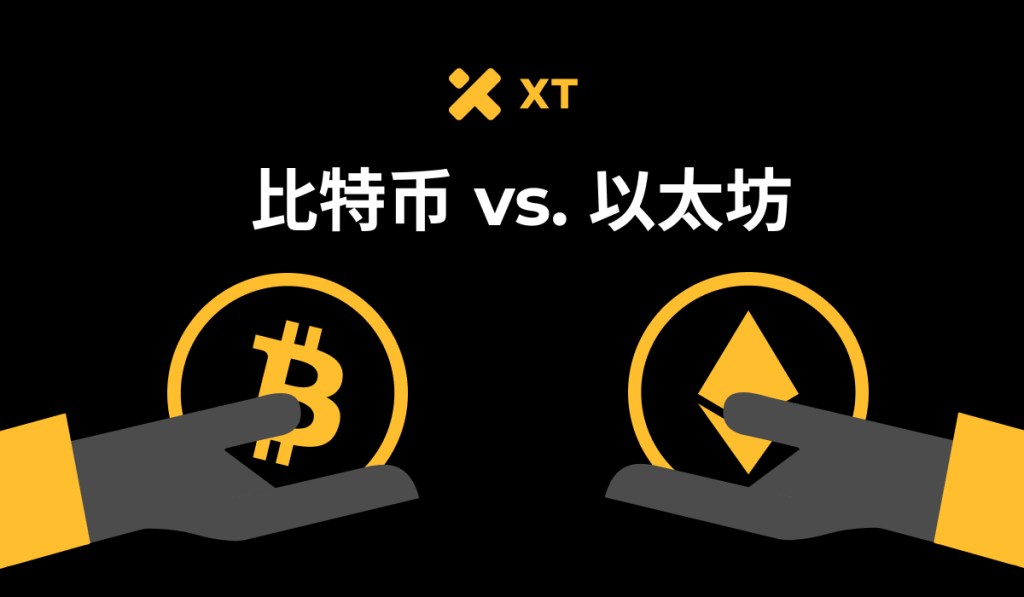
Bitcoin and Ethereum together define the current cryptocurrency landscape, but they serve entirely different purposes. "Which one is more worth buying?" is a question every investor cares about. This article will explore six dimensions: historical origins, technical differences, ecology and applications, market performance, risk profiles, and future roadmaps, to help you allocate assets between BTC and ETH.
Table of Contents
Historical Origins and Core Foundations
Technical Protocol Differences
Ecology and Application Scenarios
Market Performance and Investment Indicators
Risk Factors and Volatility Characteristics
Historical Origins and Core Foundations
Origins and Positioning
In January 2009, Bitcoin (BTC) emerged, initially positioned as peer-to-peer electronic cash, quickly regarded as "digital gold" due to its decentralization and scarcity, with prices soaring from a few cents to tens of thousands of dollars.
In July 2015, Ethereum (ETH) launched, aiming to provide a universal public chain for smart contracts and dApps, enabling richer on-chain applications.
Monetary Policy and Supply Mechanism
– Bitcoin: Total supply capped at 21 million coins, with block rewards halving approximately every four years. After the April 2024 halving, the annual issuance will drop below 1% of total supply, further enhancing scarcity.
– Ethereum: Initially had no fixed cap, with mining rewards creating new coins; after the 2021 EIP-1559 upgrade, it began burning a portion of transaction fees, and after the 2022 "merge" to PoS, new issuance roughly equals the amount burned, with inflation rates approaching zero.
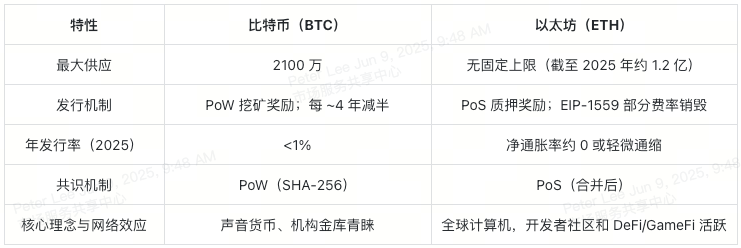
Core Philosophy and Network Effects
Bitcoin advocates for "sound money," resistant to censorship and with deep liquidity, favored by institutional treasuries and long-term value investors, thus widely regarded as digital gold.
Ethereum positions itself as a "world computer," dedicated to empowering innovative scenarios like DeFi, NFTs, and gaming. As on-chain activity increases, its issuance is more closely tied to actual demand rather than unchecked inflation.

Technical and Protocol Differences
Consensus Mechanism
Bitcoin uses Proof of Work (PoW), where miners continuously solve SHA-256 algorithm puzzles to package blocks, providing high security but consuming significant electricity.
After the "merge" in September 2022, Ethereum transitioned to Proof of Stake (PoS), reducing energy consumption by over 99%. ETH holders validate blocks and earn rewards through staking. Bitcoin itself does not support staking, so users looking to earn passive income typically use financial platforms like XT Earn.
Block Time, Throughput, and Fees
– Bitcoin: A new block is generated approximately every 10 minutes, with limited transaction throughput; during peak times (e.g., when BTC/USD futures trading is active), the memory pool can become congested, causing fees to rise sharply.
– Ethereum: A new block is produced every 12–15 seconds, allowing for higher throughput, but fees can still spike during NFT or DeFi booms. By using Layer-2 Rollups like Optimism and Arbitrum, transactions can be bundled off-chain and then submitted to the main chain, significantly reducing costs.

Security and Decentralization
Bitcoin's vast hash power network makes 51% attacks extremely costly, and upgrades like Taproot further enhance its resistance. Ethereum's PoS security relies on the amount of staked ETH, with malicious validators facing the risk of having their funds slashed. Its ongoing sharding proposal aims to improve scalability while maintaining decentralization. Both main chains have deep liquidity in the spot market, and traders often combine on-chain data with the June macro calendar to optimize strategies.
Ecology and Application Scenarios
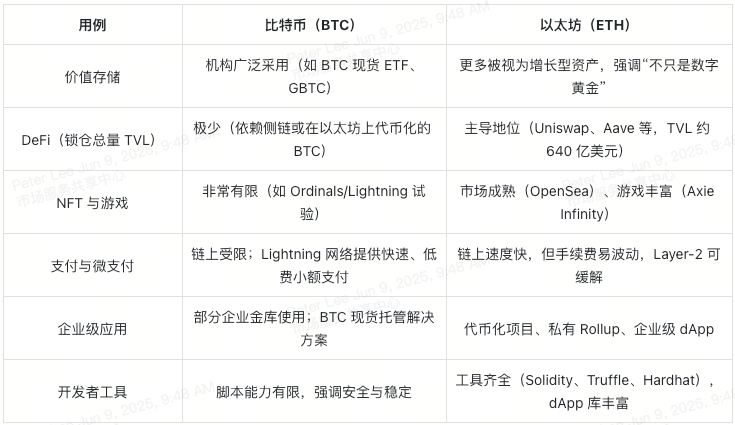
Bitcoin's Value Storage and Payment Scenarios
Institutional Applications
Bitcoin has become the preferred value storage tool for institutions and retail investors. Many companies and pension funds have incorporated BTC into their financial allocations, while products like GBTC and BTC spot ETFs allow investors to participate without managing private keys. Observing the BTC/USDT spot and BTC/USD futures often reflects market sentiment; a steady price increase indicates growing confidence in Bitcoin's long-term value.
On-chain Payments and the Lightning Network
While Bitcoin is still developing in the realm of everyday small payments, the emergence of the Lightning Network has made microtransactions feasible. On-chain fees can spike during peak periods, but Lightning offers a faster and cheaper transfer experience, especially suitable for regions with underdeveloped banking services.
Ethereum's Smart Contracts and dApp Ecosystem
NFT and Gaming
In addition to DeFi, Ethereum is also the main battleground for NFTs and blockchain games. Markets like OpenSea are thriving, and games like Axie Infinity allow creators to monetize digital artworks and game assets.
Enterprise-Level and Layer-2 Solutions
Enterprises often use Layer-2 Rollups like Optimism and Arbitrum or sidechains like Polygon to reduce gas fees and increase throughput. These scaling solutions provide feasible options for real asset tokenization and cross-border settlements.
Developer Community and Innovation Speed
Ethereum's large developer community revolves around Solidity, Web3.js, and a rich set of development libraries. Regular hackathons, various funds, and tools (Truffle, Hardhat) continuously support rapid iteration—though the complexity also brings occasional smart contract vulnerabilities. In contrast, Bitcoin typically follows a conservative upgrade path (Taproot, privacy enhancements), placing more emphasis on security rather than frequent updates, which, while impeccable in brand and stability, lacks native DeFi and complex smart contract support.
Yield Opportunities (XT Earn)
Wealth management services like XT Earn bridge the gap between "simple holding" and "passive income." Whether through packaged BTC staking solutions or directly participating in ETH staking, users can generate returns from idle crypto assets, combining value storage strategies with income generation.
Market Performance and Investment Indicators
Historical Price Trends and Correlation
Bitcoin's cyclical bull markets are legendary. In 2013, BTC price surged from under $100 to over $1,100 by November; in 2017, it skyrocketed from around $1,000 to nearly $20,000 by December; during the 2020-21 cycle, BTC rose from about $6,438 in March 2020 to an all-time high of nearly $69,000 in November 2021. By June 2025, Bitcoin's price is expected to be around $104,500.
Ethereum's growth is equally impressive, closely tied to ecological milestones. At the end of 2016, ETH price was around $8; it rose to $200 in June 2020 and reached $600 in August; the NFT boom in early 2021 pushed it to $4,800 in May. By June 2025, Ethereum's price is expected to be around $2,600.
Market Capitalization and Liquidity
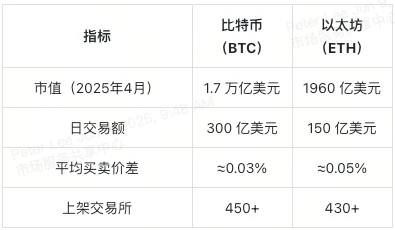
Bitcoin remains the largest cryptocurrency by market capitalization, with deep buy and sell orders and extremely low slippage; Ethereum follows closely, also with ample liquidity, though spreads may widen slightly during network congestion.
On-Chain Metrics and Network Health
Bitcoin
– Daily Active Addresses: Approximately 1.1 million, indicating good usage.
– Hash Rate: Near historical highs (>300 EH/s), showing strong miner confidence.
– "Days Destroyed" Metric: Movement of long-dormant coins often signals price volatility.
Ethereum
– Daily Transactions: Over 1.2 million, primarily driven by DeFi and NFTs.
– Staked ETH: Over 35 million locked in the beacon chain, reflecting trust in PoS and expected returns.
– Smart Contract Deployments: Approximately 2,000–3,000 new contracts weekly, indicating developer activity.
Institutional and Retail Adoption Metrics
Bitcoin
The ecosystem of Bitcoin-based ETFs continues to expand. Major issuers like Grayscale, BlackRock, and Fidelity see average monthly net inflows of about $500 million. Custody platforms also report increasing holdings from family offices and corporate treasuries, further solidifying BTC's status as "digital gold." Meanwhile, more investors are beginning to use professional Bitcoin tax software to manage their earnings.
Ethereum
The first U.S. Ethereum spot ETFs are set to launch in mid-2024, attracting about $80 million monthly. The average daily trading volume of ETH futures on CME is around $3 billion, providing a compliant trading channel for institutions. In terms of DeFi, Ethereum's total value locked (TVL) remains stable at around $65 billion, highlighting its real use value. For strategy formulation, refer to the June economic calendar to reasonably allocate investment ratios between BTC and ETH.
Risk Factors and Volatility Characteristics
Volatility Metrics
Volatility in crypto assets still exists, but Bitcoin and Ethereum's prices are more stable than ever. As of the end of May 2025, Bitcoin's 30-day realized volatility has dropped to about 1.8% (60-day around 2.4%), while Ethereum's 30-day volatility is about 2.5% (60-day around 3.0%), reflecting residual DeFi and network sensitivity. Looking back at the adjustment cycle in early 2025: Bitcoin fell from $109,000 at the end of May to $84,000 in mid-March, then consolidated before returning to $95,000 in June; Ethereum dropped 55% from its high of $4,500 in November 2024 but began to recover as the sharding testnet neared completion.
Regulatory and Security Risks
– Although Bitcoin enjoys the reputation of "digital gold," tightening mining regulations (such as power restrictions in North America) and the EU's MiCA regulations (effective mid-2025) may increase compliance costs and even affect miner location choices.
– Ethereum faces risks from smart contract vulnerabilities—such as a $100 million attack on a DeFi project in February 2025; if the full network sharding (Q3 2025) does not progress smoothly, it could pose technical and trust challenges. Additionally, there remains uncertainty over whether the U.S. SEC will classify Ethereum staking products as securities, adding another layer of regulatory risk.
Network Congestion and Fee Spikes
Bitcoin's memory pool is usually quite quiet, but during the peak popularity of Ordinals inscriptions (BTC NFTs), single transaction fees can temporarily spike above $10, making small payments nearly impractical. On the Ethereum side, thanks to Layer-2 Rollups, the average gas fee on the mainnet is about 25 Gwei (≈$2–3 per transaction), but the launch of popular DeFi projects or NFT airdrops can still trigger short-term fee spikes, temporarily pushing ordinary users out of transactions. To avoid these fluctuations, consider adjusting asset allocation strategies based on the June economic calendar.
Competition and Technological Obsolescence Risks
Bitcoin's value storage positioning remains solid, but public chains focused on real asset tokenization are increasingly attracting institutional pilots. Ethereum faces more intense competition: high-performance public chains like Solana, Avalanche, and Aptos are rapidly expanding in the DeFi and GameFi sectors. If Ethereum's sharding or Rollup roadmap experiences delays or falls short of expectations, developers and liquidity may shift to other chains, weakening ETH's network effects. To profit from high volatility and reduce taxes, consider focusing on professional Bitcoin tax software solutions.
Future Prospects and Roadmap
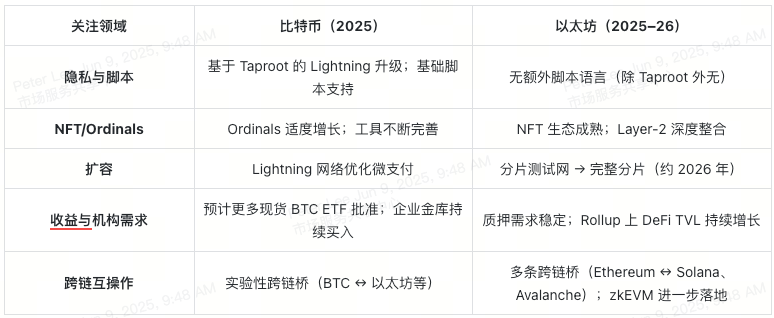
Upcoming Developments for Bitcoin
Taproot Enhancements
In 2025, improvements to the Lightning Network will be launched based on Taproot privacy and script upgrades, enabling faster and cheaper micropayments; simultaneously, a test cross-chain bridge will allow BTC to interoperate with other public chains under secure and controllable conditions.
Ordinals and Limited NFTs
Ordinals inscriptions have introduced some NFT-style applications, but the overall scale still pales in comparison to Ethereum. More user-friendly minting and tracking tools are expected, but transaction volumes will remain moderate.
Institutional Support
As U.S. regulators gradually allow spot Bitcoin ETFs, more capital is expected to flow in. The demand for BTC hedging and value preservation from corporate treasuries is on the rise, and new allocation announcements are anticipated.
Ethereum's Scaling and Protocol Upgrades
Sharding Roadmap
Multiple sharding testnets will continue to operate until the end of 2025, with plans to fully activate sharding in early 2026, potentially increasing throughput from ~15 transactions per second to tens of thousands per second while maintaining PoS security.
Layer-2 Evolution
Optimism, Arbitrum, and zkSync Rollups continue to reduce gas fees. By 2025, the average Rollup transaction fee has decreased by over 60%, making the DeFi and GameFi experience smoother; one-click cross-chain and wallet integration are also continuously optimized.
DeFi and Cross-Chain Innovation
More bridging solutions are expected to emerge (such as Ethereum↔Solana, Ethereum↔Avalanche), as well as early zkEVM Rollups that balance Ethereum-level security with lower transaction fees. As regulatory compliance requirements for DeFi tokens become clearer, protocol parties will gradually adopt compliant token models.
Macroeconomic and Technical Catalysts
Inflation and Monetary Policy
When central bank interest rates fluctuate, investors tend to view Bitcoin as "digital gold," while Ethereum benefits from the demand for on-chain financial services. For asset allocation, refer to the June economic calendar.
Growth of the Web3 Ecosystem
More wallet options, DAO tools, and real asset tokenization (RWA) are continuously generating new demand, with each new scenario adding value to ETH.
Competitive Threats
Next-generation Layer-1 public chains like Aptos and Sui are capturing market share with faster final confirmations and lower fees, challenging Ethereum's position. The advancement of central bank digital currencies (CBDCs) may also reshape the digital asset ecosystem, requiring adjustments from both the BTC and ETH communities.
免责声明:本文章仅代表作者个人观点,不代表本平台的立场和观点。本文章仅供信息分享,不构成对任何人的任何投资建议。用户与作者之间的任何争议,与本平台无关。如网页中刊载的文章或图片涉及侵权,请提供相关的权利证明和身份证明发送邮件到support@aicoin.com,本平台相关工作人员将会进行核查。




